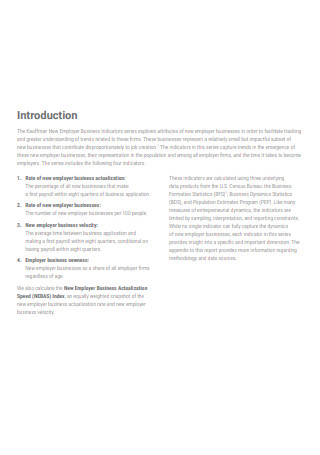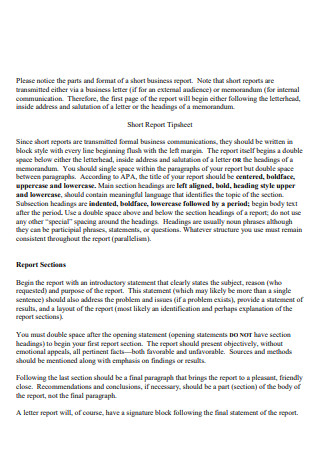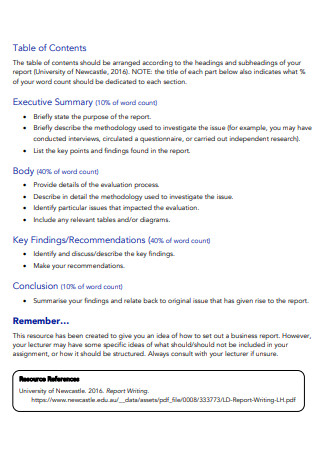3+ SAMPLE One Page Business Report
FREE One Page Business Report s to Download
3+ SAMPLE One Page Business Report
What Is a One-Page Business Report?
Factors to Consider When Writing a One Page Business Report
How to Make a One Page Business Plan
Structuring a Business Plan
Types of Business Reports
FAQs
Why one page reports are essential for business success?
Why do professionals request one-page business plans?
How to make a worthy one-pager?
What Is a One-Page Business Report?
A Business Report gives an overview of facts and analysis that assists a company in making essential information readily available. There are several sorts of company reports, but this article will walk you through the basics. Consider your audience and their expectations while writing your report. From the word itself, these business reports are mainly written and presented on just one page. Continue reading to know the purpose as to why it is only maximizing one page as opposed to having multiple pages. There are available business plan templates that you can check out to better understand the purpose of these reports and their ties to businesses in the corporate world.
Factors to Consider When Writing a One Page Business Report
Prior to starting anything, it is critical to plan. The same is true for business reports. They require you to plan and to do so, you must answer two critical questions: Who is going to read it? What is its goal? You can observe in other formal business report examples that the audience and purpose of the report are necessary to come up with a succinct report, one that will have its intended purpose being written and laid out for everyone to understand.
How to Make a One Page Business Plan
It’s critical to know how to create a good business report if you want to effectively express your ideas across industries. These studies usually target a specific subject and aid in decision-making for the issue at hand. The reports summarize your findings on the issue and then suggest a course of action for the company. The analysis and interpretation of the findings are crucial to the production of a successful report. Based on the conclusions reached and the recommendations made, the reader will have a clear idea of what to do. Writing a report does not necessitate the acquisition of any new writing skills; rather, it necessitates the sharpening of existing ones. Your findings and ideas just need to be better organized in the form of a report. Each report has its own structure and style, which will change depending on the reader. Be sure to view the one-page business report sample provided to get a clearer picture of the layout.
Step 1: Plan before you write
Handle the formal business report as if it were a project. Plan ahead of time what you want to accomplish before you start gathering information and writing parts. You will have a higher chance of writing a report in a straightforward and easy manner if you do so. It’s possible that the firm you work for already has a standard structure for formal business reports. Check your company’s manual or ask the person who will be receiving the report whether there is a preferred format. Your report will appear more professional if you follow a standard structure.
Step 2: Add a Title
At the start of the report, make sure the headline is clear and accessible. You should also include your name, the names of anybody else who worked on the report, and the date it was written. A title page informs people about the subject of the business report you are writing. This should be precise, succinct, and descriptive, giving readers a clear idea of the report’s substance.
Step 3: Write the summary
The essential aspects of a formal business report are presented in the one-page business summary. This part may be useful to the reader, but it is not required, especially if your report is brief. Although the summary appears at the beginning of the report, it should be written last, along with the contents page, so that remarks from the conclusion and recommendations section may be included. Because your boss may only have time to read the Executive Summary of the report, it must summarize the report’s main elements.
Step 4: Write an introduction
The purpose of creating the report will be explained in this part. The aim of the report and background information on the issue should be addressed in the beginning. Include any necessary definitions and a summary of the primary point. The introduction should briefly define the background, identify the subject matter in general, characterize the problem, outline the scope of the study, preview the report’s structure, and remark on the report’s limits and drawbacks, as well as the assumptions made.
Step 5: Finish with a conclusion and recommendations
This part requires you to evaluate, interpret, and make suitable conclusions from the information given in the report’s main body. They’re taken straight from the research. Always keep in mind that conclusions should be specific, structured, and should include the most essential aspects first, without any exaggeration or additional information.
Recommendations are precise, action-oriented ideas for resolving the problem that has been identified. Remember to offer precise ideas, eliminate conditional phrases, number the recommendations, clarify how they may be implemented, and order the recommendations from most important to least essential when making recommendations.
Step 6: Don’t forget to Proofread
Once you have completed writing your report, proofread it to ensure that it’s free of grammatical and spelling problems, which will improve its credibility. Furthermore, when writing, be clear and succinct. Slang and complicated words should be avoided. It’s fine to utilize jargon and technical phrases that are relevant to your sector but don’t overdo it. Make sure the text flows from one part to the next, especially if the report has many authors.
Structuring a Business Plan
The one-page business report format may seem tricky to follow through, especially if your company’s report has multiple data that you would want to present. But knowing the basic structure and components still serves as vital in setting up a concise business report. Whether you are rushing to write numerous pages for a sales report for your supervisor or cramming to finish a much lesser number of pages for an analysis for your marketing class, your business report will have many of the same features. While the recommended style varies per company, formal business reports frequently contain a number of common elements.
Types of Business Reports
If you don’t have visibility into how your company is functioning and where you can improve, it’s difficult to manage and develop it. That’s why business reports are so important for evaluating your firm and setting yourself up for success. You can identify what is and isn’t functioning by evaluating the information included in various sorts of reports, and where you can make changes and modifications by analyzing the information contained in various types of reports. Some of the most popular sorts of reports that business owners find most beneficial are listed below.
FAQs
Why one page reports are essential for business success?
The objective of a business report is to provide a critical assessment of how the firm is functioning across all areas. Firm reports are important instruments for directing decision-making and helping firm owners and senior management to investigate and address any issues that have been discovered. One-pagers push you to condense a lengthy business proposal onto a single page and concentrate solely on the most relevant aspects. This enhances your personal understanding of your business and allows you to think more clearly. It also aids in rapidly identifying flaws in your company plan so that you can focus on fixing them.
Why do professionals request one-page business plans?
When you develop a one-page business plan, you condense everything your company is about into one short document: your vision for what you want to achieve, your core values, your objectives, and your strategy for achieving those objectives or setting up a contingency plan. A business report is an assessment of a specific issue, set of conditions, or financial activities that are related to a company’s success. Its main objective is to provide critical information in a clear and succinct manner. The most significant benefit of writing a one-pager is that it allows the reader to save a significant amount of time. Since it saves your audience time in learning about your company, it can help pique their attention from the start.
How to make a worthy one-pager?
To develop a great one-page, you must pay attention to two critical factors that may make or break a one-pager: content and design. Now it’s time to talk about how to make sure you have the greatest design in place to make it eye-catching and intriguing. Your one-content pagers will only go you so far. That critical information must be presented in a professional, legible, and visually attractive manner. In order to create a great one-pager, both content and design are crucial. Writing outstanding content in a succinct way and making it aesthetically beautiful, on the other hand, may require time, effort, and a lot of back-and-forth amongst members of your team.
With all that being said, you are more than well-equipped to prepare and write out your own one page business report. Enforced with the knowledge you have gotten from this article along with the available resources and templates provided for you, you are ready to wow your audience and supervisors in coming up with an organized report that is filled with information.




